- Author Jason Gerald [email protected].
- Public 2024-01-19 22:11.
- Last modified 2025-01-23 12:04.
Instead of buying factory paint, make your own paint from cheap materials. Paints that are safe for children of all ages can be made quickly using flour or corn syrup. More experienced artists can make their own paint using raw pigments and paint mediums. If you need to paint a homemade project, try chalk paint for furniture or flour-based paint for walls. Making your own paint can be a satisfying, fun, and money-saving project.
Step
Method 1 of 5: Making Flour Based Drip Paint

Step 1. Pour the white flour, water and salt into a bowl
Pour 250 ml (1 cup) of warm water into a large bowl. Add 350 g of white flour and table salt each. Stir the mixture until it becomes a smooth watery solution.
- This mixture will produce paint that dries quickly, is non-toxic, and is safe for children of all ages.
- Adjust the amount of each ingredient to make more or less paint. Add the ingredients in the same ratio.
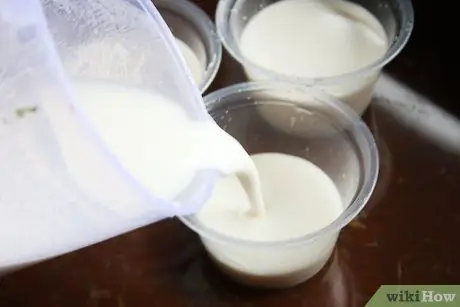
Step 2. Divide the paint into separate containers
Divide the paint evenly into several small bowls or squeeze bottles. You can also use a zipped plastic bag for paint like this.
With a zipped plastic bag, you can trim the ends slightly so that the paint drips steadily. That way, there is no risk of the paint container tipping over and spilling the contents

Step 3. Pour 2 drops of food coloring into the paint
Choose a color, then add 2-3 drops of food coloring to the paint. Create a variety of paints by adding a different color to each container. You can add a few drops of additional dye as needed if the paint color is less intense.
If you don't find a particular color, mix in a few drops of another color. For example, add 3 drops of red and 1 drop of blue to make purple

Step 4. Stir the paint to mix the food coloring evenly
If the paint is stored in an open container, stir it with a spoon or other tool. If stored in a bottle or bag, close the container and shake or knead the paint. Keep stirring until the paint color is even.
If you're using a zippered bag, open the bag slightly to allow any excess air to escape. Be careful not to squeeze the paint out of the hole
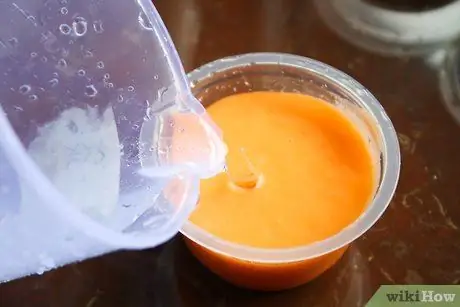
Step 5. Add water to thin the paint
Paints made using a flour mixture will appear a little thick at first. To dilute it, gradually add water to the container. Stir until the paint is the thickness you want.
- Since this paint is non-toxic, you can safely touch it or pour it from the container.
- These paints tend to be thicker than store-bought factory paints. So it's usually not very easy to deploy.

Step 6. Apply paint on paper and store the rest in the refrigerator
The best type of paper is watercolor paper, which you can buy at art supply stores. This paper is made from wood pulp or cotton and holds paint better than regular printer paper. You can also use paint on a similar surface, such as cardboard, cardboard, or canvas. Store leftover paint in a closed container and refrigerate.
Paint is safe to use up to a maximum of 2 weeks. However, the consistency will harden over time
Method 2 of 5: Making Watercolors
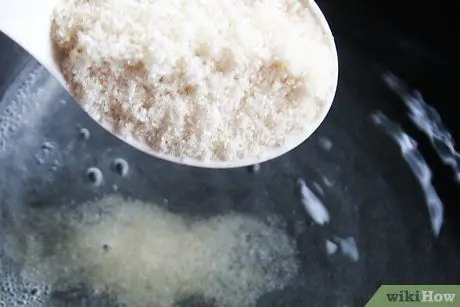
Step 1. Boil sugar and water in a saucepan
Add about 250 ml of water to a stove-safe pot. Add 500 g of white sugar. Turn the stove on to high heat until the water boils.
- If you don't want to bother, just buy light corn syrup from a grocery store. You don't have to boil anything. Just mix the syrup with the other ingredients.
- This mixture will produce paint that is non-toxic and safe for children. Compared to flour paint, corn syrup paint is easier to spread and is more like store-bought watercolor.

Step 2. Reduce the heat and stir the mixture until it becomes a syrup
Once the water starts to boil, lower the stove temperature to low heat. Keep stirring for 3-5 minutes until all the sugar is dissolved. Once the solution is a clear syrup, remove the pan from the stove.
- Scoop the solution with a spoon to check for undissolved sugar crystals.
- The longer it simmers, the thicker the consistency will be once the solution has cooled. If you boil it too long, the sugar can burn.

Step 3. Combine the baking soda, corn starch, white vinegar and corn syrup
Pour in about 1½ tbsp. or 20 ml of corn syrup from the saucepan to the mixing bowl. Add 50 ml of white vinegar. Do not forget to add baking soda and corn starch, each as much as 50 grams. Mix all the ingredients until it becomes a smooth solution.
You can find all of these ingredients at most grocery stores

Step 4. Pour the paint into small containers
Separate paint into mini bowls, like small candle holders. Use a different container for each color of paint you want to make.
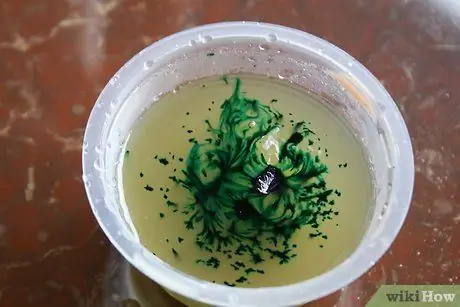
Step 5. Add 2 drops of food coloring to the paint
Choose several different dyes to make your artwork rich in color. Start with a few drops first so the paint doesn't turn out too thick. You can add more dye after the paint is stirred.
If you can't find a specific color, just mix primary colors to make one. For example, mix 2 drops of yellow and 1 drop of red to make orange

Step 6. Mix the food coloring using a toothpick
Stir the paint in the container until the food coloring is evenly distributed. Use a different toothpick for each container so the colors don't mix. After that, you can apply paint to the paper. The best surface to use is watercolor paper because it holds paint better than plain paper.
- Wash the brushes after use so the colors don't mix.
- These paints are similar to store-bought watercolors. So you can mix colors on paper. Paint also dries slowly, unless placed in a hot place.
- Paint can be stored in a closed container and refrigerated. Usually the paint lasts up to about two weeks. Just throw it away if there is mold growing in it.
Method 3 of 5: Mixing Acrylic or Oil Paints

Step 1. Wear a dust mask to protect yourself from the paint
Since you will be using a pigment and paint medium, protect yourself by wearing a mask or respirator. You should also protect your hands by wearing long-sleeved clothing.
This paint is non-toxic unless you use a metal-based pigment such as cadmium red. However, this paint should not be used on the skin

Step 2. Pour the raw color pigment onto a flat surface to mix
You will need a dry paint pigment of the desired color. Pour in about 1 tbsp. or 20 g of pigment onto a flat surface such as a paint palette or flat plate.
- You can find dry paint pigment at art supply stores. The color of each pigment will be visible and is usually properly labeled, such as “Titanium White” or “Red Iron”.
- Most artists use glass plates or stone plates. You can find acrylic glass slabs at building materials stores and use them to mix paint.

Step 3. Pour in 2 drops of water if you want to refine the pigment
Adding a little water can make the consistency of the paint better. Spread the paint to make a hole in the center of the pigment pile. Use an eyedropper or eyedropper to drip 2 or 3 drops of water into the hole in the center.
If the pigment is not completely smooth, the paint will look gritty when applied

Step 4. Stir the paint and water with a palette knife
Use a palette knife or paint knife to spread the water all over the pigment. Mix the paint until it has a smooth, sauce-like consistency. Do not leave lumps of raw pigment.
- You may not be able to stir up the entire lump of pigment right away. That's okay because the paint can be thinned out later.
- If you'll be making your own paint often, buy a paint muller online or from an art supply store. Paint muller will grind and spread the raw pigment.

Step 5. Add the paint medium to the pigment
Start with approximately 2 tbsp. or 30 ml of liquid paint medium. The medium you choose depends on the type of paint you want to make. Art supply stores sell a variety of mediums for acrylic. Or, you can buy plant-based oils to make oil paints.
- For example, you can use a gloss medium to make a light, transparent acrylic paint.
- For oil paints, use linseed, walnut, or poppy oil.

Step 6. Mix the paint and add more medium to get the right consistency
Use a palette knife or paint knife to mix the pigment and medium. Once the consistency is right, the paint will appear soft, solid, and slightly shiny. Just adjust it by adding medium as needed until the paint consistency is what you want.
- Gradually add the medium while mixing it with the paint. Continue to check the consistency of the solution so that there is not too much medium.
- Leftover paint can be placed in foil, tightly wrapped, and stored in the freezer for 2-3 months.
Method 4 of 5: Making Chalk Paint for Furniture
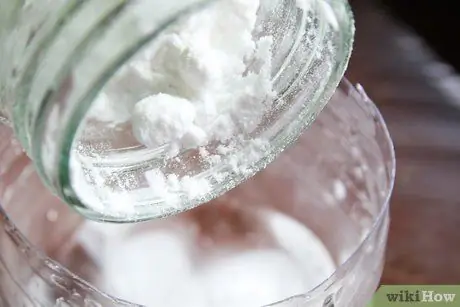
Step 1. Mix water and baking soda in a bowl
Pour 50 ml of cold water into a bowl. Use tap water at a temperature below room temperature. After that, add 100 g of baking soda.
- This paint is an inexpensive way to make furniture look old and dated.
- This paint is non-toxic, but it can make you sick for a while if you ingest it.
- Paint can also be made with gypsum cement (plaster of paris) or non-sanded grout instead of baking soda. Enter one of these ingredients as much as 100 g.

Step 2. Stir all the ingredients until it looks smooth
Mix the solution in a bowl with a spoon or other utensil. Keep stirring until all the baking soda is dissolved. This solution should look really soft.

Step 3. Pour the solution into a glass of latex paint
Pour about 250 ml of latex paint into a bowl. Choose any color paint you want. After that, add the baking soda and water mixture to the paint, stirring with a paint stir stick.
You can buy latex paint at a building materials store. Make sure the paint is latex based. Oil paint has a difference and will dry more slowly

Step 4. Apply paint to the furniture with a brush
The chalk paint will look as smooth as regular latex paint. This paint must be applied immediately to the furniture to be colored. Coat the furniture with paint to give it a dull and old look.
- The paint will set in a few hours. Wait about a day to make sure the paint is completely dry.
- Once dry, you can sand it with 180-220 grit sandpaper.
- To remove excess paint, just leave it out in the open. Since it is made of latex, this paint will dry out. After that, you can throw it in the trash.
Method 5 of 5: Making a Flour Based Wall Paint
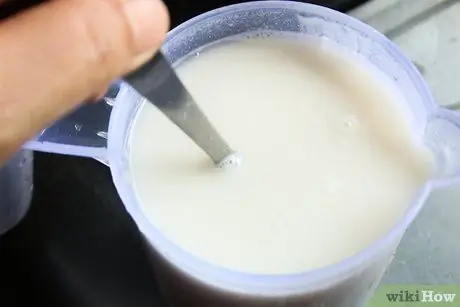
Step 1. Combine cold water and flour in a bowl
Make a mixture with cold water. Pour 470 ml of water into a bowl. Mix with 500 g of flour, then stir until the solution is smooth.
- This mixture will produce an inexpensive paint that is non-toxic and can be used to paint walls and other surfaces with a matte finish.
- These paints are similar to those sold in stores and will last for years.
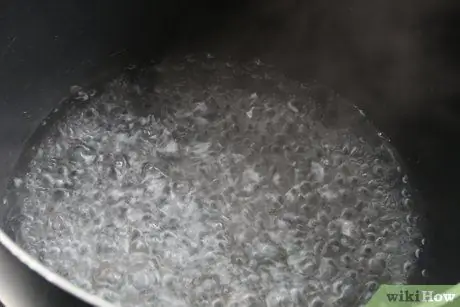
Step 2. Bring 350 ml of water to a boil on the stove
Pour about 1½ cups of water into a stovetop safe bowl. Turn the heat to high and wait for the water to boil.

Step 3. Reduce the heat and add the flour solution, then stir until it becomes a paste
Lower the heat and continue to stir the solution with a whisk or other stirring device. The solution will turn into a thick paste in 3-5 minutes. Once it becomes a paste, remove the pan from the stove.
Check the consistency of the pasta to make sure it's thick. If it looks runny, cook it longer

Step 4. Add 470 ml of cold water to the paste
Use cold water so the pasta doesn't become too runny. Slowly pour into the pasta while continuing to stir. The water will thin the paste to a paint-like consistency when stirred.
Too much water can make the paste too runny and not thick enough to cover the walls

Step 5. Mix the filtered clay and putty powder in a separate bowl
Take a new bowl and mix about 250 g of filter clay with 100 g of powdered putty, such as mica or ferrous sulfate. These materials will give the paint color and stability, preventing the paint on the walls from peeling and cracking.
- Filter clay can be purchased online or from a gardening company.
- Powdered putty is usually available at building materials stores and can also be purchased online.

Step 6. Put the two filling materials into the paste
Add the clay mixture slowly while continuing to stir. Mix all the ingredients until the paste reaches the right consistency. After that, paint can be daubed over the surface with a brush as you normally would with latex paint or regular oil paint.
The paint can be diluted again by simmering for about 30 minutes, then adding 1,000 ml of linseed oil. Cool the paint to the touch before using it

Step 7. Use the paint and store the rest in a closed container
Apply the paint over the surface you want to color, then wait for it to dry. The paint will dry about 1 hour later, and will adhere firmly within 24 hours. After that, you can apply a second coat to make the surface look nicer. Store leftover paint in a sealed container-such as a paint can-in a closet, garage, or similar area.
- Paint that is stored properly will last for 5-10 years.
- You can also let the remaining paint dry out in the open and then throw it in the trash.
Tips
- Paint can be made in many ways. So, choose the type of paint that suits your project.
- Adjust the amount of material you make with how much paint is needed so that the rest is not wasted.
- Wear an apron to avoid paint stains.






